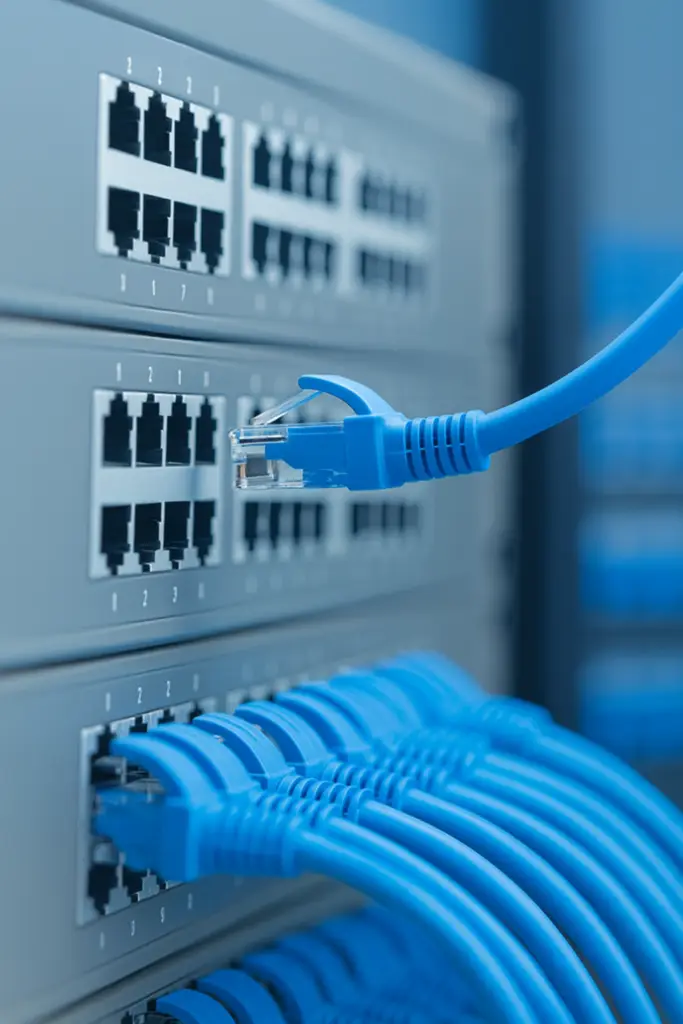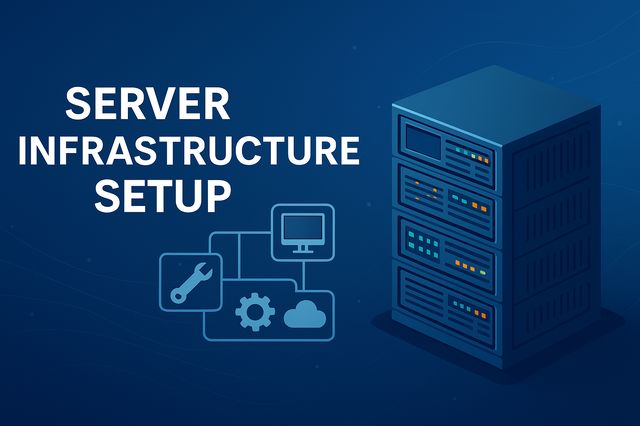Server Racks and Network Infrastructure form the physical and operational backbone of every modern SMB IT environment.
In 2025, proper rack design, cooling management, and structured cabling are essential for uptime, scalability, and compliance.
A well-planned infrastructure reduces maintenance costs by up to 30%, extends hardware lifespan, and supports hybrid IT growth turning the server rack into the digital heart of business continuity and performance.
The Real Challenge Behind Network Infrastructure
Every growing company reaches that moment when their network setup is no longer enough.
Maybe it started with one switch under a desk, a few routers, or a tangled mess of cables connecting critical systems. Then the business expanded. More employees, more devices, more data. Suddenly, what used to work becomes unstable, noisy, and impossible to maintain.
This is where the importance of a properly planned server rack and network infrastructure becomes clear.
A server rack is not just a metal cabinet | it is the foundation of your digital operations. It dictates uptime, scalability, cooling, and the long-term health of your IT environment.
Whether you are relocating your office, upgrading your network, or building a new IT room, this guide will help you make the right decisions from day one.
Planning and Design | Building the Foundation for Reliability

Before buying anything, planning is everything.
The most common mistake organizations make is rushing into hardware purchases without considering their long-term infrastructure strategy.A server rack must fit your business | physically, technically, and operationally.
The first step is to assess your current and future needs.
Assess Space and Environment
Choose a location that provides stable power, controlled temperature, and room for growth.
Avoid corners, tight closets, or rooms with inconsistent cooling.
If your office is moving, make sure the new site has reinforced flooring and access for equipment delivery.
Select the Right Rack Type
Enclosed racks protect against dust and unauthorized access.
Open frame racks are cost-effective and allow superior airflow.
Wall mounted racks are perfect for small offices or telecom closets.
The key is not aesthetics | it’s airflow, weight capacity, and accessibility.
Plan for Cooling and Airflow
Poor cooling is one of the leading causes of network failure.
Design your setup to promote front to back airflow, keep hot air away from intakes, and never block ventilation.
If your environment lacks air conditioning, consider a self-contained cooling rack or use blanking panels to optimize temperature distribution.
The Business Impact
Proper planning prevents future downtime, reduces maintenance costs, and extends equipment lifespan.
A single day of network failure can cost thousands in lost productivity and missed client connections.
Essential Hardware Checklist | What Goes Inside a Modern Server Rack
Once the space is defined, it’s time to build the backbone of your network.
Every component inside the rack must serve a specific purpose and be designed to work together seamlessly.

Core Components
Network Switches | Choose managed switches that allow VLANs, QoS, and monitoring for scalability.
Patch Panels | Label and organize every connection. A clean patch panel means faster troubleshooting.
Power Distribution Units (PDUs) | Use PDUs with surge protection and metering to monitor energy use.
Uninterruptible Power Supply (UPS) | Keeps your network alive during power loss and prevents damage from voltage spikes.
Cable Management Accessories | Horizontal and vertical organizers maintain order and airflow.
Monitoring Sensors | Track temperature and humidity to detect issues early.
Practical Additions
Rack Shelves | For routers, NAS devices, or smaller appliances.
Grounding Kits | Reduce electrical interference and protect sensitive hardware.
Lighting and Access Controls | Improve visibility and security for on-site staff.
The Business Impact
An organized rack is an efficient rack.
It saves hours during maintenance, eliminates confusion during troubleshooting, and reduces the risk of accidental disconnections.
For executives, that translates into fewer outages, lower operational costs, and greater confidence in IT stability.
Installation and Best Practices | Setting Up for Long Term Success
Now that your equipment list is ready, it’s time to install it properly.
A structured installation determines how well your network performs under pressure.
Prepare Power and Grounding
Verify the electrical circuit can handle the combined power load.
Always use redundant power sources when possible.
Ensure proper grounding to prevent static discharge and electrical faults.
Mount Equipment Strategically
Place heavier components like UPS systems at the bottom for stability.
Keep network switches at eye level for easy access.
Maintain clear separation between power and data cables to avoid interference.
Label Everything
A professional rack has every cable labeled on both ends.
Use heat shrink or printed labels that won’t fade.
This is not just aesthetics | it’s critical for efficiency and compliance audits.
Test and Document
After installation, perform full connectivity tests, verify airflow paths, and document every connection.
Use diagrams or digital documentation tools to track your layout for future maintenance or upgrades.
The Business Impact
Proper installation saves future chaos.
A well installed rack prevents accidental disconnects, allows quick expansion, and reduces mean time to repair (MTTR).
When the company grows, your IT infrastructure grows with it, without costly rework.
Optimization and Maintenance | Keeping Your Infrastructure Future Ready
Even the best rack setup requires ongoing attention.
Neglecting maintenance is one of the fastest ways to lose the benefits of a well planned system.
Routine Inspection and Monitoring
Inspect airflow and cable integrity monthly.
Review UPS battery health quarterly.
Monitor PDUs and temperature sensors for anomalies.
Replace worn cables or components before they fail.
Adopt Predictive Maintenance
Modern monitoring tools can alert you to potential failures before they occur.
This predictive approach allows you to act proactively instead of reactively, minimizing downtime.
Plan for Scalability
Technology changes fast.
When planning expansions, choose modular racks and scalable power systems that can adapt to cloud integration, edge computing, or IoT devices.
Energy Efficiency and Sustainability
Efficient cooling and smart PDUs help reduce energy consumption | a growing concern for both cost and corporate responsibility.
Investing in energy efficient infrastructure supports ESG goals and can improve compliance with ISO and ASHRAE standards.
The Business Impact
Optimization ensures long term reliability, cost predictability, and compliance readiness.
Your IT environment becomes a measurable business asset rather than a technical burden.
Conclusion | The Rack Is the Heart of Your Digital Office
A server rack is more than a cabinet | it is the central nervous system of your organization’s digital life.
Poor planning or rushed installation can compromise everything from performance to security.
When built with foresight, a rack becomes a platform for efficiency, growth, and resilience.
Whether you are expanding your data capacity, relocating your office, or simply upgrading outdated systems, this guide gives you the blueprint for success.


Because poor planning leads to overheating, downtime, and unnecessary rework.
A well-structured rack ensures airflow efficiency, organized cabling, and stable power distribution preventing outages and supporting future scalability.
Managed network switches (for VLANs and QoS)
Patch panels for organization
PDUs and UPS systems for power protection
Cable management accessories for airflow
Environmental sensors for temperature and humidity monitoring
Each element contributes to uptime, safety, and long-term reliability.
Overheating causes instability and hardware failure.
Designing front-to-back airflow, using blanking panels, and maintaining proper spacing can improve system performance by up to 20% and reduce energy consumption.
Place heavy equipment (UPS) at the bottom
Keep switches at eye level
Separate power and data cables
Label every cable on both ends
Test and document all connections post-installation
These steps improve troubleshooting speed and ensure compliance with IT standards.
Perform monthly airflow inspections, quarterly UPS tests, and use predictive monitoring tools to catch issues early.
Regular documentation and proactive replacement prevent unplanned downtime.
A properly designed network rack reduces mean time to repair (MTTR), prevents failures, and saves thousands in downtime costs.
It also improves energy efficiency and supports ESG and ISO compliance turning IT infrastructure into a measurable business asset.
References
7 Benefits of Adopting Rack Servers for Your Business – worldbusinessoutlook
5 Network Rack Challenges and How To Solve Them – amcoenclosures


